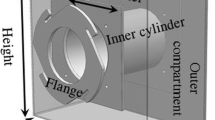Abstract
In this study we have explored the feasibility of using an isolated rat limb as an animal model for studying countercurrent arterial thermal equilibration and venous rewarming in muscle tissue. Unlike in vivo experiments in which animal models have been used for studying thermoregulation or temperature response in tissue under various physiological conditions, isolated organ or tissue provides for better control and more accurate measurement of the blood perfusion rate. It has been shown that the induced perfusion rate in the rat limb can vary from 3 ml/(min ⋅ 100 g) at normal physiological conditions to 25 ml/(min ⋅ 100g) during hyperemic conditions. Temperature distributions along the countercurrent arteries and veins have been measured using fine thermocouple wires. We observed a 25%–78% thermal equilibration along the femoral artery and its branches in intermediate size vessels between 700 and 300 μm diameter. This equilibration depends strongly on the local perfusion rate. In comparison, local perfusion rate plays a minor role in determining the overall venous rewarming in the rat hind limb. Approximately 70%–80% of the heat leaving the artery is recaptured by the countercurrent vein. This agrees well with our previous theoretical and experimental results, which show a dramatic shift in thermal equilibration between the supply artery and vein tissue cylinder and the secondary vessel tissue cylinder as the flow rate changes. © 2003 Biomedical Engineering Society.
PAC2003: 8719Uv, 8719Pp
Similar content being viewed by others
References
Akyurekli, D., L. H. Gerig, and G. P. Raaphorst. Changes in muscle blood flow distribution during hyperthermia. Int. J. Hyperthermia13:481–496, 1997.
Anderson, P., and B. Saltin. Maximal perfusion of skeletal muscle in man. J. Physiol.366:233–249, 1985.
Bonen, A., M. G. Clark, and E. J. Henriksen. Experimental approaches in muscle metabolism: Hindlimb perfusion and isolated muscle incubations. Am. J. Physiol.266:E1–E16, 1994.
Chato, J.Heat transfer to blood vessels. ASME J. Biomech. Eng.102:110–118, 1980.
Crezee, J., and J. J. W. Lagendijk. Experimental verification of bioheat transfer theories: Measurement of temperature profiles around large artificial vessels in perfused tissue. Phys. Med. Biol.35:905–923, 1990.
Crezee, J., J. Mooibroek, C. K. Bos, and J. J. W. Lagendijk. Interstitial heating: Experiments in artificially perfused bovine tongues. Phys. Med. Biol.36:823–833, 1991.
Gorski, J., D. A. Hood, and R. L. Terjung. Blood flow distribution in tissues of perfused rat hindlimb preparations. Am. J. Physiol.250:E441–E448, 1986.
He, Q., L. Zhu, D. E. Lemons, and S. Weinbaum. Experimental measurement of the temperature variation along artery-vein pairs from 200 to 1000 μm diameter in rat hind limb. ASME J. Biomech. Eng.124:656–661, 2002.
Hettiarachchi, M., K. M. Parsons, S. M. Richards, K. A. Dora, S. Rattigan, E. Q. Colquhoun, and M. G. Clark. Vasoconstriction-mediated release of lactate from the perfused rat hindlimb. J. Appl. Physiol.73:2544–2551, 1992.
Kolias, M. C., A. E. Worthington, M. D. Sherar, and J. W. Hunt. Experimental evaluation of two simple thermal models using transient temperature analysis. Phys. Med. Biol.43:3325–3340, 1998.
Lemons, D. E., S. Chien, L. I. Crawshaw, S. Weinbaum, and L. M. Jiji. The significance of vessel size and type in vascular heat transfer. Am. J. Physiol.253:R128–R135, 1987.
Pennes, H. H.Analysis of tissue and arterial blood temperatures in the resting human forearm. J. Appl. Physiol.1:93–122, 1948.
Raaymakers, B. W., J. Crezee, and J. J. Lagendijk. Comparison of temperature distributions in interstitial hyperthermia: Experiments in bovine tongues versus generic simulations. Phys. Med. Biol.43:1199–1214, 1998.
Ruderman, N. B., C. R. S. Houghton, and R. Hems. Evaluation of the isolated perfused rat hindquarter for the study of muscle metabolism. Biochem. J.124:39–651, 1971.
Shiota, M., and T. Sugano. Characteristics of rat hindlimbs perfused with erythrocyte-and albumin-free medium. Am. J. Physiol.251:C78–C84, 1986.
Song, J., L. X. Xu, S. Weinbaum, and D. E. Lemons. Enhancement in the effective thermal conductivity in rat spinotrapezius due to vasoregulation. ASME J. Biomech. Eng.119:461–468, 1997.
Song, J., L. X. Xu, S. Weinbaum, and D. E. Lemons. Microvascular thermal equilibration in rat spinotrapenius muscle. Ann. Biomed. Eng.27:56–66, 1999.
Valvano, J. W., S. Nho, and G. T. Anderson. Analysis of the Weinbaum–Jiji model of blood flow in the canine kidney cortex for self-heated thermistors. ASME J. Biomech. Eng.116:201–207, 1994.
Weinbaum, S., and L. M. Jiji. A new simplified bioheat equation for the effect of blood flow on local average tissue temperature. ASME J. Biomech. Eng.107:131–139, 1985.
Weinbaum, S., L. X. Xu, L. Zhu, and A. Ekpene. A new fundamental bioheat equation for muscle tissue: Part I–blood perfusion term. ASME J. Biomech. Eng.119:278–288, 1997.
Wu, Z. Y., L. P. Rivory, and M. S. Roberts. Physiological pharmacokinetics of solutes in the isolated perfused rat hindlimb: Characterization of the physiology with changing perfusate flow, protein content, and temperature using statistical moment analysis. J. Pharmacokinet Biopharm.21:653–688, 1993.
Xu, L. X., M. M. Chen, K. R. Holmes, and H. Arkin. The theoretical evaluation of the Pennes, the Chen–Holmes and the Weinbaum–Jiji bioheat transfer models in the pig renal cortex. ASME, WAM, Atlanta, HTD-189:15–22, 1991.
Zhu, L., D. E. Lemons, and S. Weinbaum. A new approach for prediction the enhancement in the effective conductivity of perfused muscle tissue due to hyperthermia. Ann. Biomed. Eng.23:1–12, 1995.
Zhu, L., D. E. Lemons, and S. Weinbaum. Microvascular thermal equilibration in rat cremaster muscle. Ann. Biomed. Eng.24:109–123, 1996.
Zhu, L., L. X. Xu, Q. He, and S. Weinbaum. A new fundamental bioheat equation for muscle tissue: Part II–temperature of SAV vessels. ASME J. Biomech. Eng.124:121–132, 2002.
Author information
Authors and Affiliations
Rights and permissions
About this article
Cite this article
He, Q., Zhu, L. & Weinbaum, S. Effect of Blood Flow on Thermal Equilibration and Venous Rewarming. Annals of Biomedical Engineering 31, 659–666 (2003). https://doi.org/10.1114/1.1569265
Issue Date:
DOI: https://doi.org/10.1114/1.1569265




